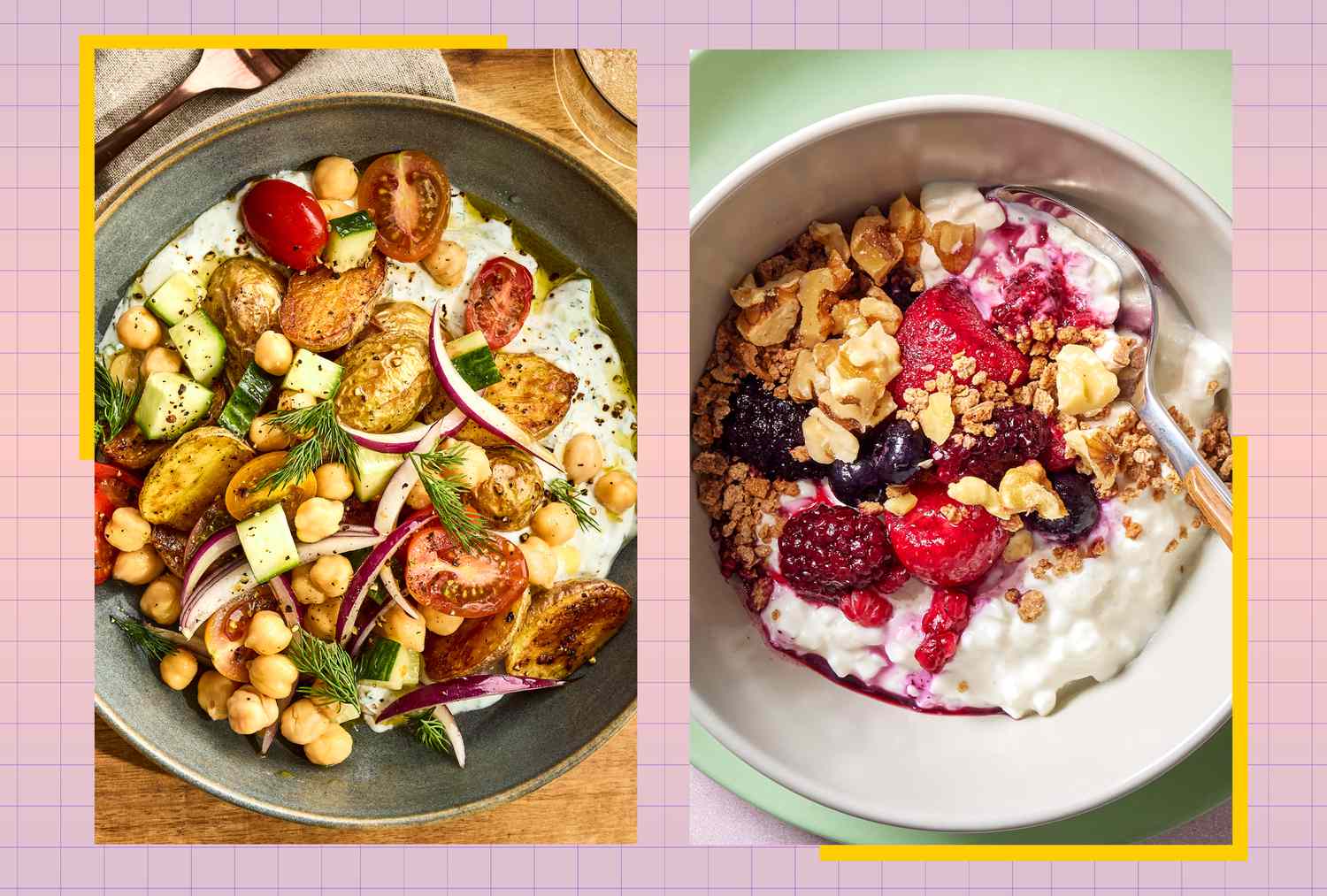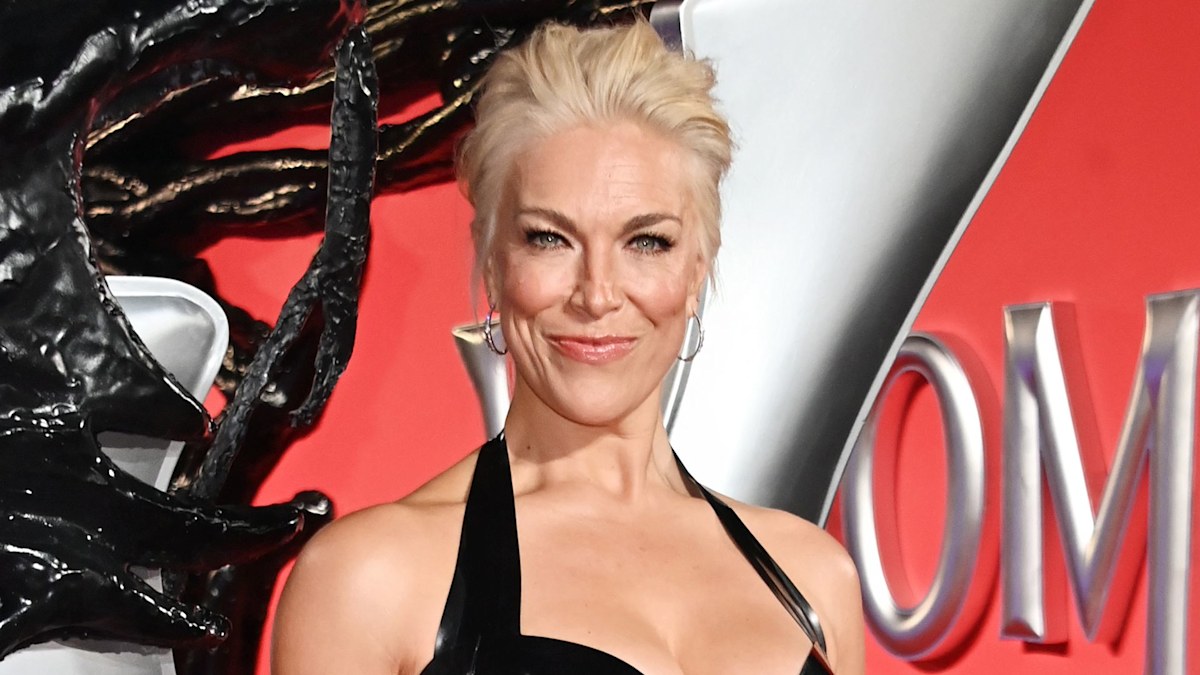
7-Day No-Sugar, High-Protein Meal Plan for Spring, Created by a Dietitian
| Meal Plan at a Glance | ||
|---|---|---|
| Breakfast/ AM Snack | Lunch/ PM Snack | Dinner/ Evening Snack |
| Egg tortilla/ Cottage cheese bowl | Green goddess wrap/ Buffalo chickpeas | Salmon with melting leeks |
| Mango smoothie/ Cottage cheese bowl | Cabbage salad with chicken/ Energy bites | Fritter salad/ Stuffed mini peppers |
| Yogurt parfait/ Almonds | Cabbage salad with chicken/ Energy bites | Penne with turkey & mushrooms |
| Egg tortilla/ Yogurt parfait | Cabbage salad with chicken/ Energy bites | Chicken & broccoli salad/ Apple |
| Yogurt parfait/ Buffalo chickpeas | Avocado tuna salad/ Energy bites | Tzatziki bowls |
| Yogurt parfait/ Cottage cheese bowls | Avocado tuna salad/ Energy bites | Chicken skillet with rice/ Apple & nut butter |
| Egg tortilla/ Cottage cheese bowl | Green goddess wrap/ Energy bites | Fish taco bowl/ Yogurt parfait |
Day 1
Photographer: Jen Causey, Food Stylist: Jennifer Wendorf, Prop Stylist: Christina Brockman
Breakfast (370 calories)
A.M. Snack (170 calories)
Lunch (406 calories)
P.M. Snack (109 calories)
Dinner (742 calories)
Daily Totals: 1,797 calories, 82g fat, 104g protein, 171g carbohydrate, 39g fiber, 1,991mg sodium.
Make it 1,500 calories: Omit A.M. snack and P.M. snack.
Make it 2,000 calories: Add 1 serving Apple with Cinnamon Almond Butter as an evening snack.
Day 2
Breakfast (427 calories)
A.M. Snack (170 calories)
Lunch (384 calories)
P.M. Snack (261 calories)
Dinner (413 calories)
Evening Snacks (122 calories)
Daily Totals: 1,778 calories, 91g fat, 97g protein, 158g carbohydrate, 31g fiber, 1,578mg sodium.
Make it 1,500 calories: Omit P.M. snack.
Make it 2,000 calories: Add 1 medium apple to lunch and add a 1-oz. slice of whole-wheat baguette to dinner.
Day 3
Photographer: Jen Causey, Food Stylist: Margaret Monroe Dickey, Prop Stylist: Christina Daley
Breakfast (301 calories)
A.M. Snack (206 calories)
- ¼ cup unsalted dry-roasted almonds
Lunch (384 calories)
P.M. Snack (261 calories)
Dinner (625 calories)
Daily Totals: 1,778 calories, 102g fat, 104g protein, 141g carbohydrate, 28g fiber, 1,365mg sodium.
Make it 1,500 calories: Omit P.M. snack.
Make it 2,000 calories: Add 1 serving Apple with Cinnamon Almond Butter as an evening snack.
Day 4
Photographer: Jen Causey, Food Stylist: Julian Hensarling, Prop Stylist: Josh Hoggle
Breakfast (370 calories)
A.M. (301 calories)
Lunch (384 calories)
P.M. Snack (261 calories)
Dinner (394 calories)
Evening Snacks (95 calories)
Daily Totals: 1,806 calories, 97g fat, 104g protein, 147g carbohydrate, 31g fiber, 1,801mg sodium.
Make it 1,500 calories: Omit A.M. snack.
Make it 2,000 calories: Add 2 Tbsp. almond butter to evening snack.
Day 5
Photographer Victor Protasio, Food Stylist Chelsea Zimmer, Prop Stylist Christina Daley
Breakfast (311 calories)
A.M. Snack (109 calories)
Lunch (375 calories)
P.M. Snack (261 calories)
Dinner (514 calories)
Daily Totals: 1,789 calories, 88g fat, 94g protein, 169g carbohydrate, 41g fiber, 1,673mg sodium.
Make it 1,500 calories: Omit P.M. snack.
Make it 2,000 calories: Add 1 serving Cottage Cheese Snack Jar with Fruit as an evening snack.
Day 6
Photographer: Brie Goldman, Food Stylist: Holly Dreesman, Prop Stylist: Gabriel Greco
Breakfast (301 calories)
A.M. Snack (170 calories)
Lunch (375 calories)
P.M. Snack (261 calories)
Dinner (414 calories)
Evening Snack (291 calories)
- 1 medium apple
- 2 Tbsp. almond butter
Daily Totals: 1,812 calories, 98g fat, 90g protein, 156g carbohydrate, 31g fiber, 1,212mg sodium.
Make it 1,500 calories: Omit evening snack.
Make it 2,000 calories: Add 1 serving Massaged Kale Salad to dinner.
Day 7
Breakfast (370 calories)
A.M. Snack (170 calories)
Lunch (406 calories)
P.M. Snack (261 calories)
Dinner (478 calories)
Evening Snack (139 calories)
Daily Totals: 1,821 calories, 88g fat, 93g protein, 175g carbohydrate, 31g fiber, 2,059mg sodium.
Make it 1,500 calories: Omit orange at breakfast and omit P.M. snack.
Make it 2,000 calories: Add 1 serving Spinach Smoothie to breakfast.
Frequently Asked Questions
-
Is it OK to mix and match meals if there is one I do not like?Yes, if there’s a meal you don’t like, feel free to repeat a meal in this plan or browse more of our no-added-sugar and high-protein recipes for additional inspiration For reference, we aimed for at least 90 grams of protein and 28 grams of fiber per day and also capped the sodium at 2,300 milligrams per day, as recommended by the 2020-2025 Dietary Guidelines for Americans.
-
Can I eat the same breakfast or lunch every day?You can eat the same breakfast or lunch option every day, if it’s easier for your routine. Each option we selected is a protein-rich meal, so a simple swap should work for most people. If you’re closely monitoring calories or other nutrients, you may want to adjust a snack or two to meet your goals.
-
Why is there not a modification for 1,200 calories?We no longer provide modifications for 1,200-calorie days in our meal plans. The 2020-2025 Dietary Guidelines for Americans suggests that limiting calories to 1,200 per day is too low for most people to meet their nutritional needs, plus it’s unsustainable for long-term health and well-being.
-
What’s the difference between added sugars and natural sugars?Added sugars refer to sugar or sweeteners that are added during processing. These include honey, maple syrup, white sugar, high-fructose corn syrup and more. They are added to increase the palatability of foods and have little to no nutritional value. Natural sugars are sugars that are naturally occurring in a food. Foods with natural sugars include unsweetened dairy, fruits and vegetables.
How Added Sugars May Impact Your Health
It’s not surprising to most that added sugars aren’t exactly beneficial to our health. But you may be surprised to hear that the average American adult consumes 17 teaspoons of added sugar each day. Added sugars aren’t just found in sweetened beverages and desserts; you’ll often find them in cereals, granola bars, salad dressings, breads, crackers, nut butters and more. Because these sugars add calories but minimal nutritional benefit (depending on the type of added sugar), excess intake can lead to some serious health consequences. Research links a high intake of added sugars with an increased risk of developing type 2 diabetes, heart disease, obesity, cancer and reduced cognitive function.
While we opted to skip added sugars in this plan, they certainly don’t need to be completely off the table. Researchers recommend limiting added sugars to 25 grams, or about 6 teaspoons, per day. If you’re trying to cut back on your added sugar intake, take a glance at the nutrition label to see where they are making their way into your routine. You may be surprised!









